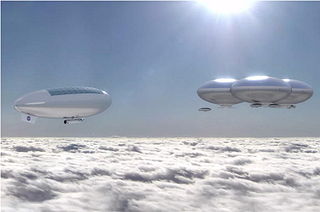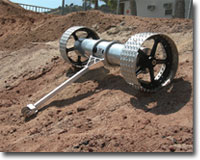
Terraforming or terraformation is the hypothetical process of deliberately modifying the atmosphere, temperature, surface topography or ecology of a planet, moon, or other body to be similar to the environment of Earth to make it habitable by Earth-like life.

Mariner 1, built to conduct the first American planetary flyby of Venus, was the first spacecraft of NASA's interplanetary Mariner program. Developed by Jet Propulsion Laboratory, and originally planned to be a purpose-built probe launched summer 1962, Mariner 1's design was changed when the Centaur proved unavailable at that early date. Mariner 1, were then adapted from the lighter Ranger lunar spacecraft. Mariner 1 carried a suite of experiments to determine the temperature of Venus as well to measure magnetic fields and charged particles near the planet and in interplanetary space.

An aerobot is an aerial robot, usually used in the context of an unmanned space probe or unmanned aerial vehicle.

Mars 3 was a robotic space probe of the Soviet Mars program, launched May 28, 1971, nine days after its twin spacecraft Mars 2. The probes were identical robotic spacecraft launched by Proton-K rockets with a Blok D upper stage, each consisting of an orbiter and an attached lander. After the Mars 2 lander crashed on the Martian surface, the Mars 3 lander became the first spacecraft to attain a soft landing on Mars, on December 2, 1971. It failed 110 seconds after landing, having transmitted only a gray image with no details. The Mars 2 orbiter and Mars 3 orbiter continued to circle Mars and transmit images back to Earth for another eight months.

An automaton is a relatively self-operating machine, or control mechanism designed to automatically follow a properations, or respond to predetermined instructions. Some automata, such as bellstrikers in mechanical clocks, are designed to give the illusion to the casual observer that they are operating under their own power. Since long ago, the term is commonly associated with automated puppets that resemble moving humans or animals, built to impress and/or to entertain people.

The Magellan spacecraft was a 1,035-kilogram (2,282 lb) robotic space probe launched by NASA of the United States, on May 4, 1989, to map the surface of Venus by using synthetic-aperture radar and to measure the planetary gravitational field.

Colonization of the Moon is a concept employed by some proposals of establishing permanent human settlement or robotic presence on the Moon, the closest astronomical body to Earth, and the Earth's only natural satellite.

Venus is a planet with striking geology. Of all the other planets in the Solar System, it is the one nearest to Earth and most like it in terms of mass, but has no magnetic field or recognizable plate tectonic system. Much of the ground surface is exposed volcanic bedrock, some with thin and patchy layers of soil covering, in marked contrast with Earth, the Moon, and Mars. Some impact craters are present, but Venus is similar to Earth in that there are fewer craters than on the other rocky planets that are largely covered by them.

Observations of the planet Venus include those in antiquity, telescopic observations, and from visiting spacecraft. Spacecraft have performed various flybys, orbits, and landings on Venus, including balloon probes that floated in the atmosphere of Venus. Study of the planet is aided by its relatively close proximity to the Earth, compared to other planets, but the surface of Venus is obscured by an atmosphere opaque to visible light.

The colonization of Venus has been a subject of many works of science fiction since before the dawn of spaceflight, and is still discussed from both a fictional and a scientific standpoint. However, with the discovery of Venus's extremely hostile surface environment, attention has largely shifted towards the colonization of the Moon and Mars instead, with proposals for Venus focused on habitats floating in the upper-middle atmosphere and on terraforming.

The NASA Institute for Advanced Concepts (NIAC) is a NASA program for development of far reaching, long term advanced concepts by "creating breakthroughs, radically better or entirely new aerospace concepts". The program operated under the name NASA Institute for Advanced Concepts from 1998 until 2007, and was reestablished in 2011 under the name NASA Innovative Advanced Concepts and continues to the present. The NIAC program funds work on revolutionary aeronautics and space concepts that can dramatically impact how NASA develops and conducts its missions.

The atmosphere of Venus is the layer of gases surrounding Venus. It is composed primarily of carbon dioxide and is much denser and hotter than that of Earth. The temperature at the surface is 740 K, and the pressure is 93 bar (1,350 psi), roughly the pressure found 900 m (3,000 ft) underwater on Earth. The Venusian atmosphere supports opaque clouds of sulfuric acid, making optical Earth-based and orbital observation of the surface impossible. Information about the topography has been obtained exclusively by radar imaging. Aside from carbon dioxide, the other main component is nitrogen. Other chemical compounds are present only in trace amounts.

Venera-D is a proposed Russian space mission to Venus that would include an orbiter and a lander to be launched in 2029. The orbiter's prime objective is to perform observations with the use of a radar. The lander, based on the Venera design, would be capable of operating for a long duration on the planet's surface. The "D" in Venera-D stands for "dolgozhivushaya," which means "long lasting" in Russian.

A mechanical computer is built from mechanical components such as levers and gears, rather than electronic components. The most common examples are adding machines and mechanical counters, which use the turning of gears to increment output displays. More complex examples could carry out multiplication and division—Friden used a moving head which paused at each column—and even differential analysis. One model sold in the 1960s calculated square roots.

The Venus In Situ Explorer (VISE) has been a lander mission concept proposed since 2003 by the Planetary Science Decadal Survey as a space probe designed to answer fundamental scientific questions by landing and performing experiments on Venus.

A Mars habitat is a place that humans can live in on Mars. Mars habitats must contend with surface conditions that include almost no oxygen in the air, extreme cold, low pressure, and high radiation. Alternatively, the habitat may be placed underground, which helps solve some problems but creates new difficulties.

Martian lava tubes are volcanic caverns on Mars that are believed to form as a result of fast-moving, basaltic lava flows associated with shield volcanism. Lava tubes usually form when the external surface of the lava channels cools more quickly and forms a hardened crust over subsurface lava flows. The flow eventually ceases and drains out of the tube, leaving a conduit-shaped void space which is usually several meters below the surface. Lava tubes are typically associated with extremely fluid pahoehoe lava. Gravity on mars is about 38% that of Earth's, allowing Martian lava tubes to be much larger in comparison.

DAVINCI+ is a planned mission for an orbiter and atmospheric probe to the planet Venus. Together with the VERITAS mission, which will also study Venus, it was selected by NASA on 2 June 2021 to be part of their Discovery Program.

Zephyr is a concept of a robotic Venus rover for a mission called Venus Landsailing Rover. This mission concept would place a rover on the surface of Venus that would be propelled by the force of the wind. The rover would be launched together with a Venus orbiter that would perform both communications relay and remote atmospheric studies.

Moon Diver is a proposed lunar mission concept by NASA's Jet Propulsion Laboratory that would employ a robotic lander and a two-wheeled rover called Axel to investigate the exposed geological layers on the walls of a deep lunar pit.






















